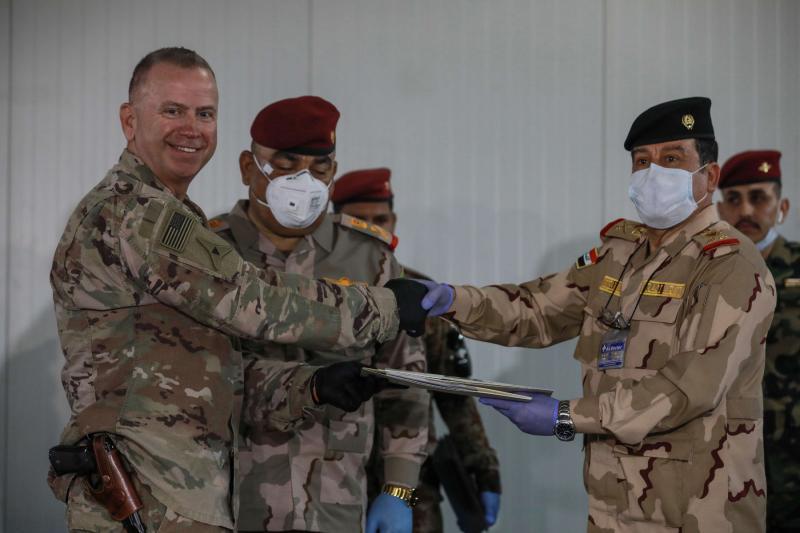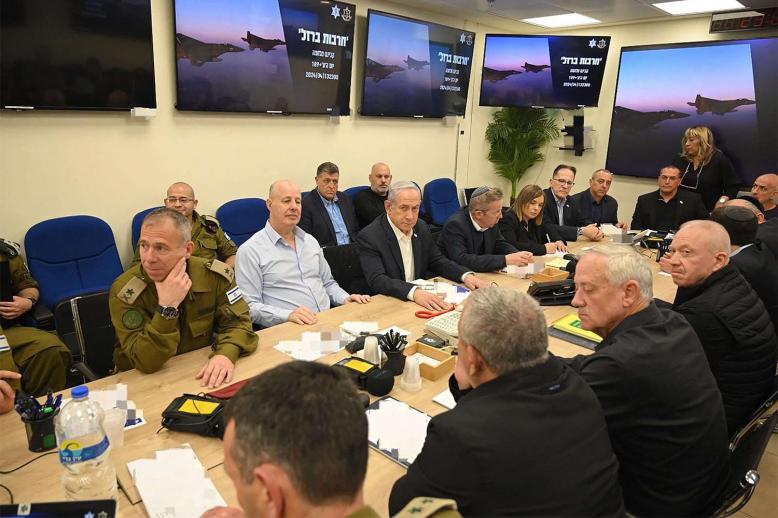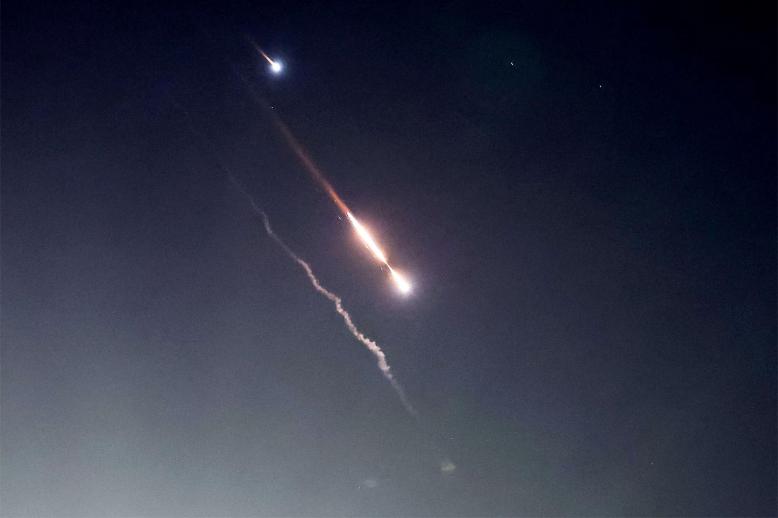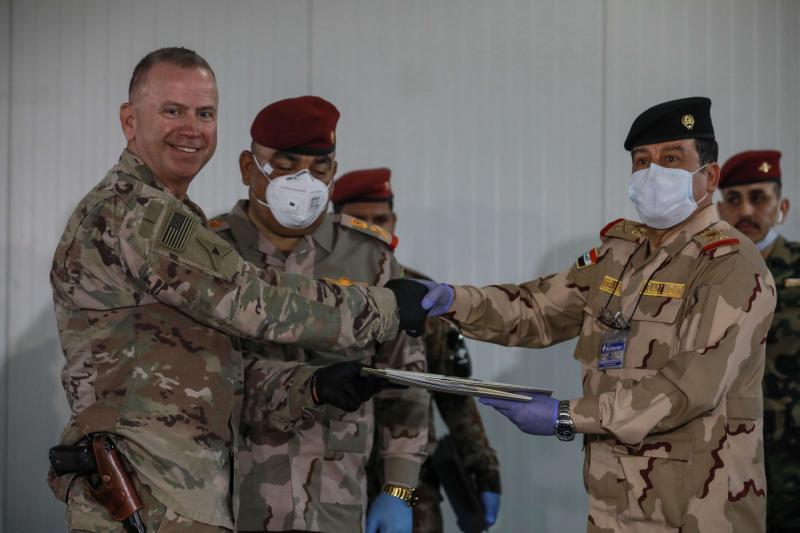Strategic repositioning of troops preserves Washington’s place in Iraq but for how long?
The inclination to celebrate the repositioning of American troops from five military sites to smaller bases as Iraq’s “long-awaited withdrawal” has subsided as headlines probe Washington’s intentions. What pundits initially cheered as a withdrawal stands out as a temporary retreat. As Iraqi actors beholden to Iran drive towards a strategic reset of US-Iraqi relations, their attempt to derail America’s trajectory is unlikely without a potential showdown.
Relations took a nosedive following a slew of rocket attacks against American personnel by Iran-backed paramilitaries aligned with the Popular Mobilisation Forces (PMF). This, since January, caused a noticeable shift in Washington’s operational priorities. No longer solely fixed on the preservation of its political supremacy inside Iraq’s domestic arena, Washington is re-channelling its energies and resources to confront the threat ardent militias pose to its security interests.
“The US is not withdrawing from Iraq,” an unnamed American State Department official told Abu Dhabi newspaper The National.
“We are committed to a partnership and friendship with Iraq.” In contrast to the consistency of American policy thinking, actors Washington courted in 2003 are switching gears, resolved to end their 17 year-old alliance of convenience.
Militias loyal to Iran are raising the ante as Baghdad finds itself caught in the middle of what former Prime Minister Adel Abdul-Mahdi described as the “politics of you are with us or against us” — alluding, however, not to the pressure applied by Tehran but by Washington. The resignation of Iraq’s latest Prime Minister-designate Adnan al-Zurfi — who was replaced by militia-approved ex-intelligence chief Mustafa Kadhimi — opens a strategic window for Iran to test the limits of its rivalry with America to stay top dog.
Unlike the honeymoon phase of the Washington-Baghdad relationship, the dwindling cast of players on which America can co-opt explains its altered operational designs that advance military end-goals before defence diplomacy. American officials have confirmed that Patriot missile launchers have been relocated to Ain Al-Asad airbase and a shorter range rocket defence system at Camp Taji.
In late March, Parliamentary Security and Defence Committee member Karim Muhamadawi hinted at the inevitable eventuality of an American attack against PMF positions, stressing that “Iraqis are ready for all options.”
Posturing from Iraq’s newest militia, the League of Revolutionaries (Usbat al-Thaireen), epitomises their patron’s antagonistic stance towards America, as distilled in the group’s recent propaganda drone footage in which it claims to have identified key military positions and US aircrafts at Ain Al-Asad airbase. “We are monitoring your movements,” one video concluded in a direct warning to America.
America’s intention to pursue aggressive action against Iran’s proxies has been widely condemned in press circles but mirrors Iranian tactics against US positions in Iraq following US President Donald Trump’s order to assassinate Iranian Major-General Qassem Soleimani of the Islamic Revolutionary Guard Corps (IRGC) in Iraq in January. Kata’ib Hezbollah retaliated a week later, firing “a volley of rockets” at Camp Taji that killed three US coalition personnel, the New York Times reported at the time.
Earlier this month, Trump warned Iran that it “will pay a heavy price” for any “sneak attack on US troops and/or assets in Iraq.”
Iranian attempts to crank up the pressure to fast-track America’s departure by legislative means have been in haste. The strategy has failed to yield the desired outcome even since Iraq’s parliament voted in favour of expelling American and foreign troops — a decision whose symbolic value outweighs its viability.
These moves intend to undermine security cooperation between Washington and Baghdad, whose fate since 2003 is a matter no longer contemplated by its people alone.
Since October 2019, Iraqi masses took to the streets in protest against the political order and countries freeloading off Iraq’s resources. Opposition to America’s overstay was a marked feature of these uprisings but more pronounced was the people’s denouncement of Iranian encroachment in their country.
It is fair to say that the two warring powerhouses have diametrically opposed methods while sharing the same goal: uncontested influence over Iraq’s resources and key institutions.
America’s repositioning move buys Washington time needed to solidify its presence and relocate its automated air defence system to intercept Iranian missiles. Its use will not be without lethal and profound consequences, however.
Contrary to wishful thinking by Iraq’s pro-Iran camp, American presence, which stretches across 14 military positions in Iraq’s north and west, cannot be eradicated at the speed of a lightning bolt. But pressure will continue to mount as General Frank McKenzie, commander of US Central Command, previously told the Senate Armed Services Committee.
However, military dominance alone cannot guarantee Washington’s place in Iraq. Bilateral security relations must be mended, which requires trusted friends that America currently lacks. Militias will seize on the chance to exploit these weaknesses to establish favourable conditions that protect its status-quo in Iraq and only time will tell how fruitful Tehran’s alliance with the newest Kadhimi-led government will be.
Nazli Tarzi is a London-based contributor to The Arab Weekly.
This article was originally published in The Arab Weekly.





